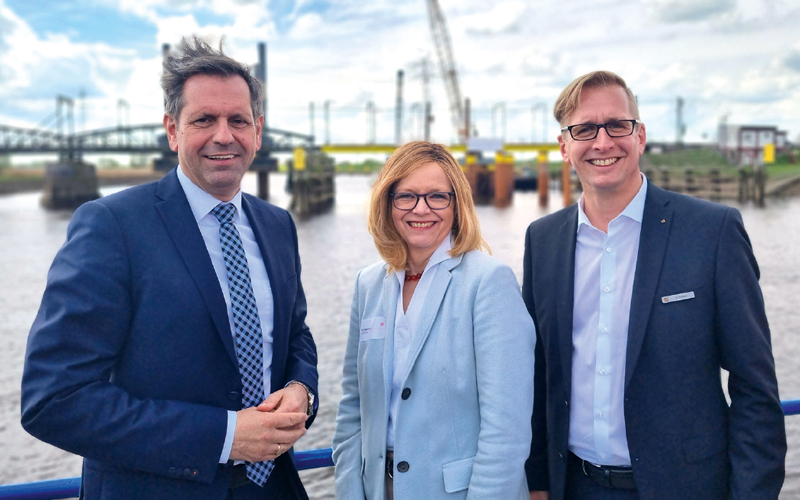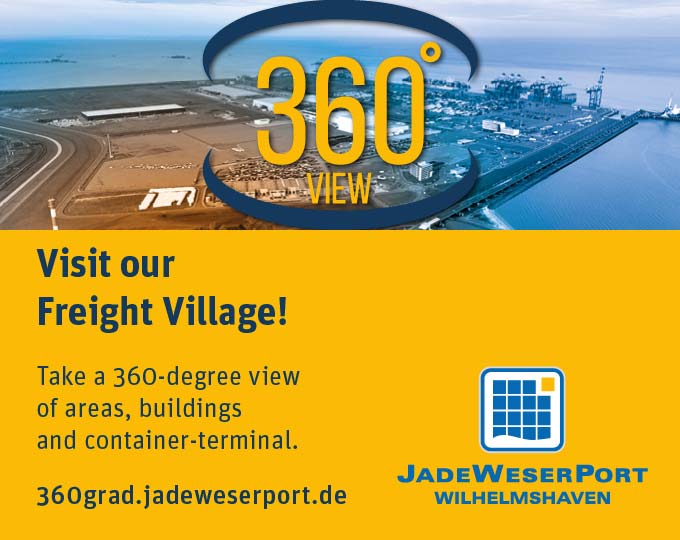Whilst the bridge collision on the River Hunte in Elsfleth poses an enormous challenge for the port industry, it has also revealed what is possible if everyone involved and those affected in business and politics work together to achieve solutions.
For example, the rail service between Elsfleth and Berne was suspended and shipping restricted. Whilst the southern passage is closed to all vessels, the northern passage was reopened a short time later with the bridge closed. However, there are some limitations. The upriver “mountain” route is permitted and the downriver “valley” route is possible in coordination with the “Warning System”, which warns captains of any dangers. However, the current clearance height is only suitable for inland vessels. Taller seagoing vessels cannot pass under the bridge.
The ports most affected by the missing rail link are Nordenham and Brake, as rail is responsible for much of the hinterland transport. The absence of seagoing ships and limited tide-dependent accessibility for inland vessels have largely impacted the port of Oldenburg.
Nordenham can only switch a portion of transport to the road
What this means for the Port of Nordenham is that the large quantities usually transported by rail have been suspended. The transport of coal is very problematic, as not all of it can be shifted to waterways. The accident has even had a direct impact on the zinc smelting plant, which receives between 4,000 and 5,000 tonnes of material by train and around two deliveries by inland waterway every month.
According to Lower Saxony’s Ministry of Economic Affairs, the issue regarding waterway transport can be remedied as follows: some rail transport has been reallocated to the road. However, this has increased freight rates to 170 to 180 truckloads a month. Continued growth in zinc production makes the closed bridge issue all the more acute.
Brake turns to Bremen for transshipment
The effects are equally noticeable at the Lower Weser. “Nearly 2.5 million tonnes of different goods – some of them critical – are transported by rail from the port of Brake alone every year,” reported Michael Kurz, Mayor of Brake. “Around 43 per cent of total shipping freight transshipped reach or leave the port by rail,” added Uwe Schiemann, spokesperson for J. MÜLLER AG. This largely affects the transport of steel, cellulose and wood, as well as grains, feed and other bulk cargo.
To maintain these volumes to the highest degree possible, J. MÜLLER has worked with customers to develop tailored solutions and alternatives. For example, trains with grains and feed are unloaded at the terminal in Cuxhavener Strasse in Bremen and, from there, transported to cereal facilities. “We even use Bremen as a transshipment location for other goods such as wood and cellulose to compensate for the suspended traffic to and from Brake,” said Schiemann. However, this solution is much more expensive for the port services provider.
“Rail tracks that hadn’t been used in a long time had to be reactivated and a few locomotives transported to Bremen to make it happen,” explained Carsten Rogge, Head of the Dock Railway at bremenports. “The maintenance depot of bremenports’ Dock Railway department also worked with its contractual partners to bring the rails up to scratch.” Furthermore, J. Müller was provided access to other unused rails such as rail track 19 at the inland port (Reitbrake). All that happened in just over two days. According to Schiemann, coordination and collaboration with the authorities and bremenports was quite constructive, fast and effective.

Oldenburg shifts to trucks, too
As a port that combines both seagoing and inland transport, the Port of Oldenburg located in the heart of the Weser-Ems region can also feel the effects of the bridge collision, which are not limited to the suspension of seagoing vessels and restricted tide-dependent accessibility for inland vessels.
“This affects around 110 seagoing vessels and, with an assumed reallocation rate of around 15 per cent, approximately 600 inland vessels annually,” stated Nico Steudel, Managing Director of the Rhein-Umschlag corporate group and member of the Oldenburger Hafenwirtschaftsgemeinschaft management board. “That applies to inland vessels heading for the Port of Oldenburg as well as any vessels passing along the coastal canal from the Weser to the Ems or the other way round. That’s approximately 4,000 inland waterway trips per year.”
It is estimated that there will be a shift from seagoing and inland transport to other forms of transport – most notably the roads in the region. “You can expect to see around 240 truckloads for each seagoing vessel with an estimated 3,000 tonnes and around 120 truckloads for each inland vessel with an estimated 1,500 tonnes.”
Finding a joint solution
The response was quick. Just one day after the accident, Lower Saxony’s Ministry of Economic Affairs organised a meeting for all those affected. “Getting everyone involved together so soon after the accident really paid off, as it allowed us to get to work minimising damages,” explained Olaf Lies, Lower Saxony’s Minister for Economic Affairs. “It’s been working really well so far – due largely to the fact that Deutsche Bahn promptly made the project a priority.”
Things also moved quickly with the temporary bridge, which has been up and running since late April, but cannot open to allow ships through. Only inland vessels that are low enough can pass through when the tide allows – larger seagoing vessels cannot. Furthermore, the temporary bridge had to be built 30 centimetres lower than the damaged railway swing bridge, the tide window for the passage of inland vessels to and from Oldenburg is now even shorter.
According to a Deutsche Bahn spokesperson, no timeframe had yet been defined for building the new movable bridge by the editorial deadline. However, “the plans for rebuilding the existing rotating structure from 1927 were already in the preliminary stages. An accelerated process to begin construction earlier is currently under assessment.” Everyone involved, from politicians and economists to Deutsche Bahn, had already begun discussing the issue in meetings. According to the Ministry’s spokesperson, the original construction period was 2027 to 2030. A shorter timeline would be another good sign for everyone involved. (cb)






